There are few adventures I enjoy more than wandering along the rural back roads of ‘real’ Florida - away from high rise beach condos, congested business centers, and crowded theme parks. Today I am on my way to visit the bilingual, early childhood and prekindergarten program at Jo Sheppard Head Start Child Development Center (Jo Sheppard Head Start). It is a peaceful morning, and after the late night rain the Florida air is clean and the land lies quietly sated. The two lane road winds through expansive ferneries and undeveloped Florida woods. I didn’t pass a single car along the way, but I did see a pair of robust, Red Tailed Hawks, heard a few beleaguered roosters crowing late, and came to a full stop for an impressive Gopher turtle lumbering across the road. Time had slowed down. I knew it would be a good day.
The Jo Sheppard Head Start facility, a colorful building poised on well-kept grounds and nestled under tall Florida pines and shady oaks, was unusually quiet when I pulled into the parking lot. The school has several playgrounds but all were empty. I did a quick survey and realized the equipment was wet and shiny puddles had collected at the end of the slides and under the swings. It would take a few hours of Florida sunshine to dry the earth - perhaps in time for afternoon recess. Children, in and of themselves are special populations; but this little bilingual school serves a very special population, the Mexican migrant community in North Volusia County, Florida. Most of the families work in the local ferneries and though it is hard, physical work, it is a participatory community. The parents are very involved with the school’s activities.
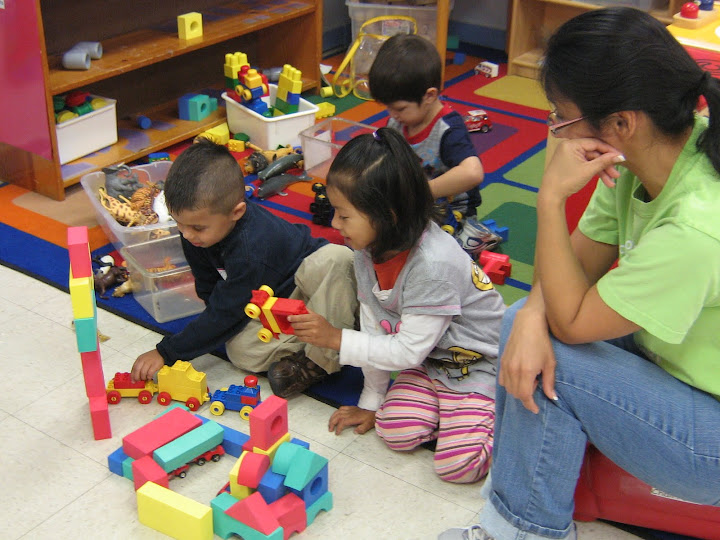
The minute I walked in I heard sounds familiar - music, singing, and children laughing. I took a peek into the classrooms and found a lot of movement, plenty of stretching, and a general, organized chaos. The teachers and assistants were enthusiastically involved in the dancing. The focus on physical activity before commencing the morning work proved to be a smart start to a day with these active and healthy three to five year olds. The children were fully engaged and clearly enjoying themselves. Across the lunch room I could see Ana and the kitchen staff preparing a ‘home cooked’ family style nutritional lunch. It smelled delicious, and comforting.
The Jo Sheppard Head Start Child Development Center is but one of the federally-funded Head Start programs and state-funded Voluntary Prekindergarten (VPK) programs that Mid Florida Community Services, Inc. administers in Hernando, Sumter, and Volusia counties. These programs serve low-income families and provide health, mental health, nutrition, and dental services to the enrolled children, which I am convinced, are all critical services to the academic success of any child. Both family advocates for this Center, Aurea Santiago and Carmen Villanueva, work diligently and selflessly to make sure the migrant community is not only aware of the services available to them and their children, but also that they access these services.

The challenges are formidable, however. Immigrant populations are reticent to pursue services available, or follow through with referrals for needed health care because, though their children are U.S. citizens, some parents are undocumented and they will not take risks. The first step for teachers and family advocates is to gain their trust, and this takes time. The other major challenge is the language barrier. Many members of the migrant community do not access services because they need a translator until they acquire adequate English skills themselves; and this, too, takes time. Though translation services exist, the fees are quite often beyond what they can pay on their limited wages. Thankfully, the family advocates make themselves as available as possible to help provide the families with these translations services, as both of them are bilingual. The Head Start family advocates and classroom teachers do home visits and help acclimate new families; and despite the tempestuous political climate surrounding immigration in our country today, what these dedicated women are able to accomplish is admirable. They spoke freely and honestly with me and I kept hearing the words of Margaret Mead in my head, “Never doubt that a small group of thoughtful, committed citizens can change the world; indeed, it's the only thing that ever has.”
I was anxious to get into the classrooms and Jackie Olivieri, the Child Development Specialist, graciously welcomed me to make myself at home. She had previously arranged my visit with the teachers and staff, for which I was grateful. I was free to meander between the three classrooms, observe, take photos, and interact as necessary. I slipped into one of the classrooms. A little boy named Manuel walked up and extended his small hand to me. I literally had to get down on one knee to meet his shy gaze, face to face. “Good morning, and welcome to my school,” he greeted me. He had such small hands. I haven’t been in the company of children this young in a long time; but I quickly remembered how refreshing it can be, how truly inspiring. The center is a warm and welcoming place inside - bustling with happy activity.
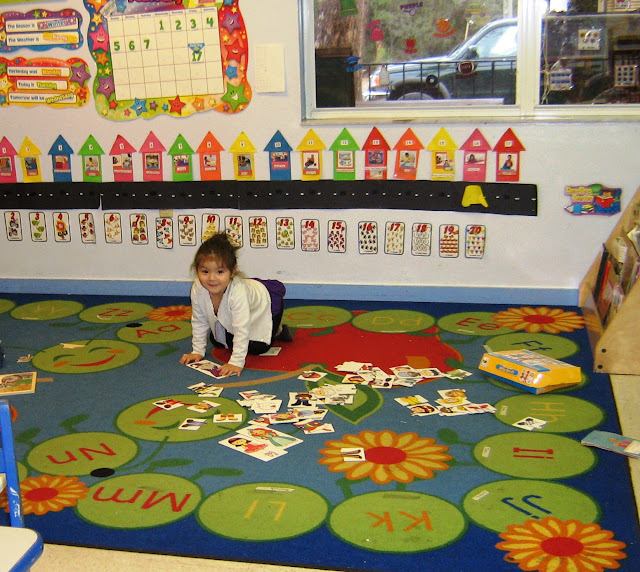
The letter for the week was “Mm” so each classroom planned their activities accordingly. Last week the letter was “Bb” and it joined the alphabet wall in each classroom. Because the center follows the High Scope Early Childhood curriculum, the students are allowed a certain amount of autonomy in choosing their morning activity. This encourages self-directed, engaged learning and encourages higher order thinking skills. The children think about what they want to do and why, and then they choose an activity. As a result the activities in each classroom are varied, but curriculum specific. In one class the children were looking for the letter “Mm” in printed material or tracing the complete alphabet. In another class the children were making sand paper letters they were sounding out, and would later trace. I wasn’t surprised when the lead teacher, ‘Mrs. Joseline’, told me she was Montessori trained. In another class the children were ‘stamping’ the letter “Mm” - and every other letter, of course, because stamping is just too much fun. Curiously, they were not stamping each other, a good sign, but atypical for this age group.
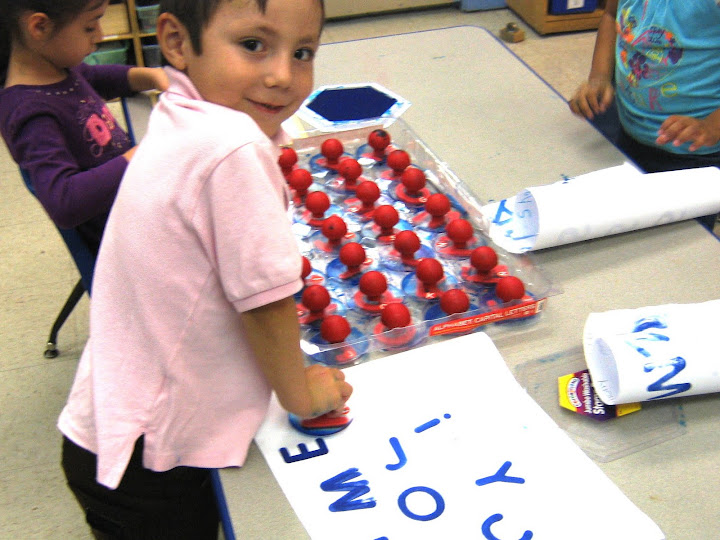

The computer is a favorite activity center and in all classes the children focus intently on the learning games. The classrooms are cozy, linguistically rich environments. I found myself focusing on the “word wall” in each classroom and the list of vocabulary words under each letter. The English language is ever present and visually reinforced, yet the staff is in tune to offering conversation in both languages in an effort to support the children’s home language. Every third week the curriculum changes ‘zones’ or ‘themes’, which the class discusses during ‘large group’ time. The current theme is “Construction Zone” so when the ‘small group’ or individual activities began, the children scattered on the colorful, kid-friendly rugs, and began ‘constructing’ just about anything they could imagine with the materials available: letters with clay, puzzle figures, Lego towers and associated contraptions, buildings and garages of colorful foam shapes, and still others were constructing ‘works of art’ in the painting area.
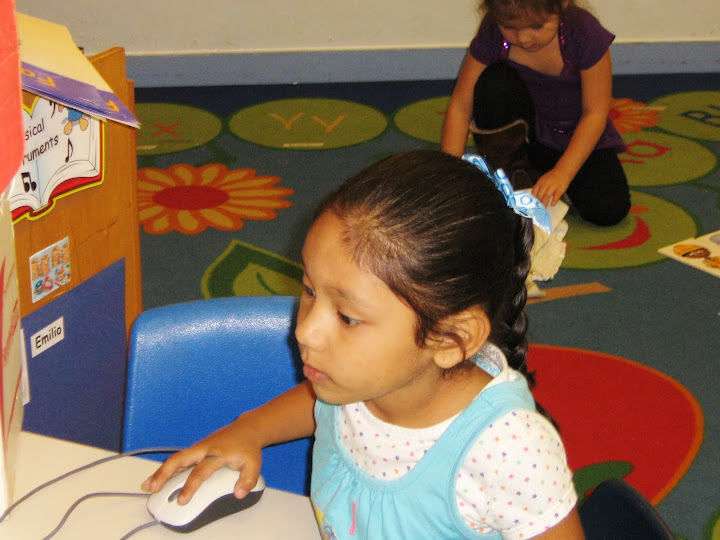
The children stayed busy and engaged the entire morning; and for the most part, ignored me except for the occasional smile or quizzical look. I listened to their conversations. Some spoke English with near native fluency and pronunciation. Some children alternated languages. Others, who I later found out had only been in the States a few weeks or months, spoke Spanish with each other, but received all their directions or instructions from their teachers in English. English is certainly the predominant language of instruction, but the teachers used Spanish when visuals and hand gestures failed to clarify or convey necessary meaning.
I heard one little boy who apparently had only been in the States a very short time say to the assistant during the sand letter activity, “Yo no puedo” [I can’t] and firmly but gently she responded, “Sí, tú puedes” [Yes, you can]. Then she continued the instructions in English, modeling what the words meant and what the children were supposed to be doing. He caught on, apparently needing only a little reassurance. The teachers reinforce the students constantly and encourage them to use the English language as much as possible. To encourage reading at home, the school has its own lending library, too, and the families check out books on a regular basis.

Though still busily working, two kids spontaneously started and stopped different choruses of “Old McDonald”, as if they were singing some verses in their heads and some out loud. I found myself chuckling, especially when one little girl who had been quietly working suddenly asks the other little girl working at her table, “Do you like my shirt”? The other little girl looked up, studied the shirt in question, then quickly responded, “Oh yes, it’s very pretty”. That was it, back to work. Some children clearly preferred to work alone and specifically told their teachers they would be working alone, which I found quite interesting. Others created little communities of activity. I did not witness any negative or disruptive incidents. Not one.
What I did observe is a solid group of well-trained teachers guiding the cognitive, emotional, and linguistic development of the children in a variety of ways. The teachers and support staff hail from a variety of countries: Peru, Puerto Rico, the Dominican Republic, Mexico, El Salvador, and one teacher, a Florida native, did not speak Spanish beyond a few key commands. Nevertheless, ‘Mrs. Donna’ who has 22 years early childhood teaching experience, feels right at home with the Mexican community and lauded the “appreciative parents”. She commented that many parents often ask for her class because they are anxious, and want their children to learn English as quickly as possible. They request her class thinking if the children cannot use the Spanish language with the teacher, they will strive harder to learn English.
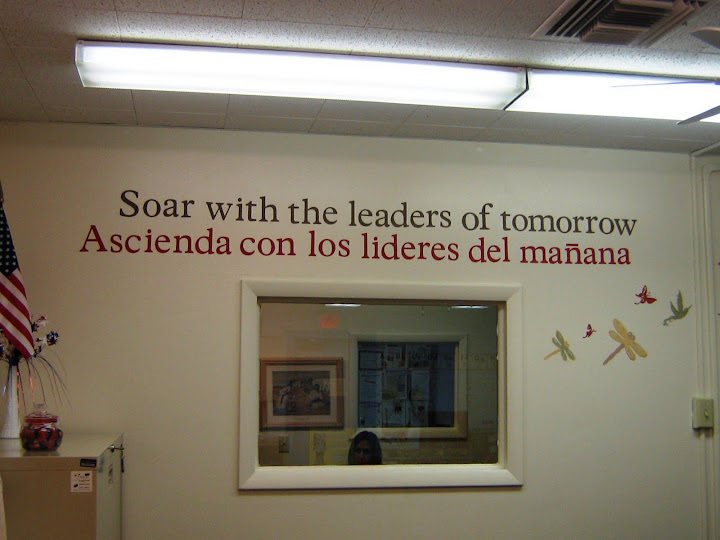
The other teachers confirmed this is exactly the parents’ perception and though all of them support the immigrant parents for wanting their children to assimilate as quickly as possible, they also agreed that the children need to be proficient in their native language as well. What often happens is newly arrived immigrants want their children to fit into the dominant community and the desire for them to learn English takes precedence and overrides the proficient acquisition of their own native language. Sometimes the child stops using Spanish altogether. This is certainly not the ideal. There is substantial research indicating that people learn a new language much faster if they have proficiency in their native language.
I was delighted the teachers were aware of this developmental finding and that the Center’s focus remains bilingualism: acquire English and develop Spanish. The school is a model for Bilingual education, and Jackie Olivieri, the center’s Child Development Specialist, gets very animated when discussing her commitment to multilingual proficiency. She laughs and says, “mi casa es loca” [my house is crazy] but my kids will learn all their languages”. She and her husband are raising their children trilingual. Her husband speaks Italian, she speaks Spanish, and they learn English in school and in the community. Though English is certainly stressed at Jo Sheppard Head Start, Spanish is not discouraged. The children are the beneficiaries of this commitment.
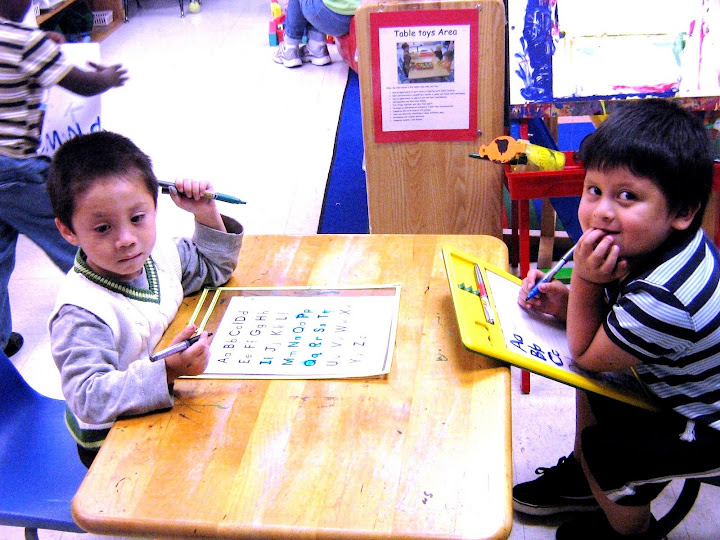
What I found especially refreshing is each classroom is its own community within the larger community. Using a weekly ‘job chart’ the children rotate individual responsibilities. ‘Mrs. Rosalyn’, who emanates the exuberance of youthful energy despite her knee injury, explained much of the curriculum to me including “Second Step”, which encourages good choices, shared narratives, and a harmonious learning environment, “Galileo” the computer software system the teachers use to track the progress of each student, and Galileo’s “Acuscreen Developmental Screening” the assessment instrument the teachers use to develop individualized education plans for each student and to also determine if referrals for further evaluations should be considered. She also explained the clever job charts, which fascinated me.
The chores are varied and can be anything from the class ‘Meteorologist’ who steps outside the classroom to report on the weather, to the ‘Tooth Brush Monitor’ who makes sure the children have brushed their teeth, rinsed their brushes, and cleaned up after themselves. Her class even has an “Inspector” for quality control after group clean-up! ‘Mrs. Rosalyn’ also developed a weekly parent newsletter called ‘Home Connection’ that keeps the parents informed on what their children are doing in her class. The other teachers have since adopted this idea. The teachers all work very hard to ensure their students ultimately enjoy a smooth transition into their public school kindergarten classes. It is clear the teachers love the community they serve. This little school is changing the world…one child at a time…one family at a time.
The children progress, and the parents right along with them. The Center has developed a special monthly “male involvement” series of activities to encourage fathers to participate. These activities are generally planned on Fridays so fathers can attend. One particularly successful event was “Daddy Cooks with Me”. The teachers affirm that the children are ecstatic when their fathers participate in events at school; so they also plan fun field trips, seasonal festivals, and regular meetings to keep the parents involved. Parental involvement, dedicated teachers and staff, a commitment to bilingualism, the health-team screenings, and the many other support services the program provides the migrant children and their families, all ensure that these children are given the best chance possible to develop their gifts and talents. The Jo Sheppard Head Start Child Development Center is a facility well-worth visiting; an example of the good work being done in our country on a daily basis. I, for one, left on a wave of cheery hopefulness.
Thank you to Director Heidi Rand, Assistant Director Donna Maas, and all teachers and staff who generously participated.
Maria Alvarez is the ESL Editor for Wandering Educators
All photos courtesy and copyright Maria Alvarez.
